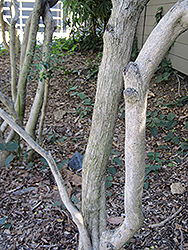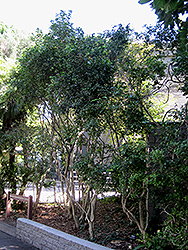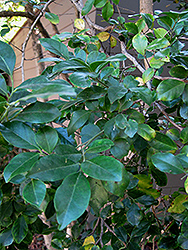It's all about ...
plants

Height: 20 feet
Spread: 12 feet
Sunlight:
![]()
![]()
Hardiness Zone: 9b
Other Names: syn. Murraya exotica
Description:
A tropical to sub-tropical tree or shrub that may grow 20 feet, but is usually smaller; can be maintained as a hedge; rich green glossy foliage; white fragrant flowers and red fruit appear all season; an attractive, exotic screen or accent plant
Ornamental Features
Orange Jessamine features showy clusters of fragrant white flowers at the ends of the branches from late winter to late fall. It has attractive dark green evergreen foliage which emerges light green in spring. The glossy oval leaves are highly ornamental and remain dark green throughout the winter. The fruits are showy red drupes carried in abundance from late winter to late fall. The smooth gray bark adds an interesting dimension to the landscape.
Landscape Attributes
Orange Jessamine is a multi-stemmed evergreen tree with an upright spreading habit of growth. Its average texture blends into the landscape, but can be balanced by one or two finer or coarser trees or shrubs for an effective composition.
This is a relatively low maintenance tree, and can be pruned at anytime. It is a good choice for attracting birds to your yard. It has no significant negative characteristics.
Orange Jessamine is recommended for the following landscape applications;
- Accent
- Hedges/Screening
- General Garden Use
- Container Planting
Planting & Growing
Orange Jessamine will grow to be about 20 feet tall at maturity, with a spread of 12 feet. It has a low canopy with a typical clearance of 2 feet from the ground, and is suitable for planting under power lines. It grows at a fast rate, and under ideal conditions can be expected to live for 60 years or more.
This tree does best in full sun to partial shade. It prefers to grow in average to moist conditions, and shouldn't be allowed to dry out. It is not particular as to soil type or pH. It is somewhat tolerant of urban pollution. This species is not originally from North America.
Orange Jessamine is a fine choice for the yard, but it is also a good selection for planting in outdoor pots and containers. Its large size and upright habit of growth lend it for use as a solitary accent, or in a composition surrounded by smaller plants around the base and those that spill over the edges. It is even sizeable enough that it can be grown alone in a suitable container. Note that when grown in a container, it may not perform exactly as indicated on the tag - this is to be expected. Also note that when growing plants in outdoor containers and baskets, they may require more frequent waterings than they would in the yard or garden. Be aware that in our climate, most plants cannot be expected to survive the winter if left in containers outdoors, and this plant is no exception. Contact our experts for more information on how to protect it over the winter months.
This plant is not reliably hardy in our region, and certain restrictions may apply; contact the store for more information.


